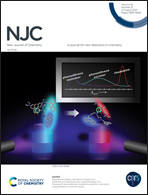Interaction of aryl tetrazolones with anions: proton transfer vs. hydrogen bonding†
Abstract
In this study, the interaction of two monosubstituted aryl tetrazolones, namely 1-(4-nitrophenyl)-1,4-dihydro-tetrazol-5-one 1a and 1-(4-trifluoromethylphenyl)-1,4-dihydro-tetrazol-5-one 1b, with anions of varying basicity e.g. hydrogen sulfate (HSO4−), bromide (Br−), nitrate (NO3−), thiocyanate (NCS−), chloride (Cl−) and acetate (AcO−) was investigated in acetonitrile and DMSO. UV and NMR titrations indicated that tetrazolones interact through hydrogen bonding or weak electrostatic interactions with HSO4−, Br−, NO3−, NCS−, and Cl−. The association constants (Ka) were found to be in the order Cl− > Br− > NO3− > NCS− > HSO4−. Tetrazolones 1a,b exhibited almost 9 times higher selectivity towards Cl− compared to Br− which may be attributed to the higher basicity of the former. The affinity of 1a towards most anions was higher than 1b, except for HSO4−. This was attributed to the higher electron withdrawing ability of the –NO2 group compared to –CF3 that renders the N–H proton more acidic for interaction with anions resulting in higher Ka values. Significant UV changes were observed upon addition of the AcO− anion to the solution of 1a,b in acetonitrile as new bands formed and isosbestic points were observed indicating the formation of a new species. NMR titrations in DMSO-d6 further confirmed that 1a,b underwent deprotonation with AcO− owing to its higher basicity.



 Please wait while we load your content...
Please wait while we load your content...